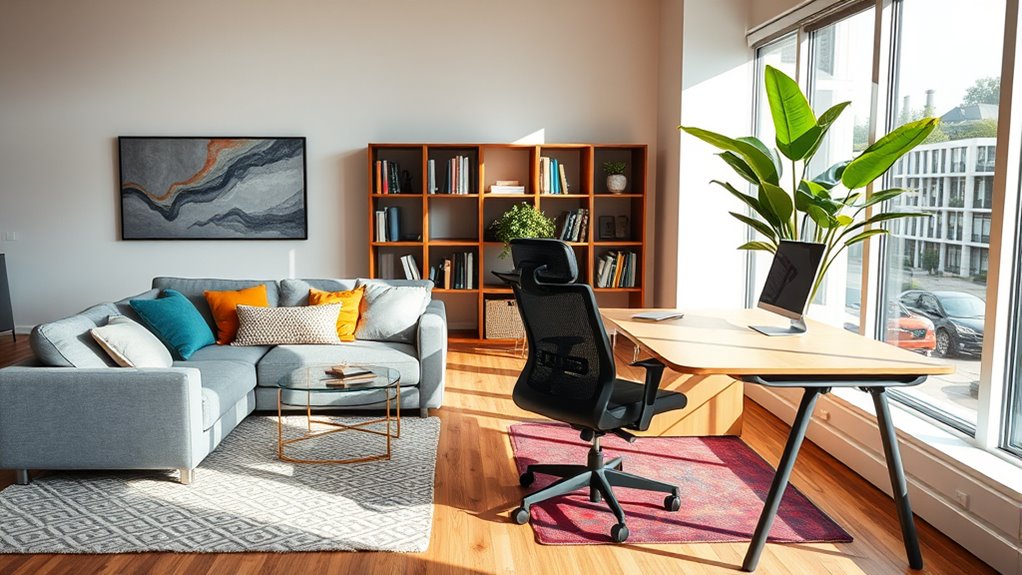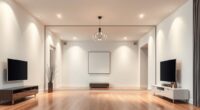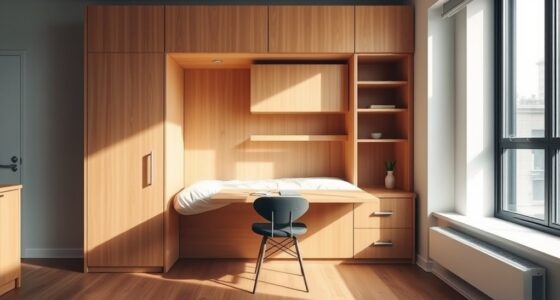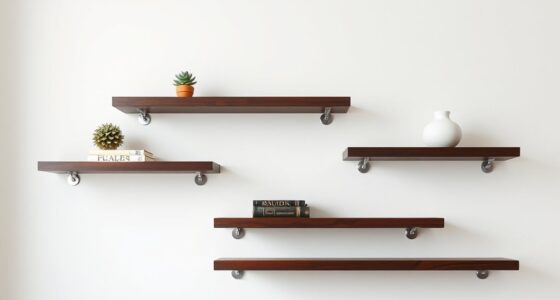To create a multifunctional room that combines living and work spaces, focus on versatile furniture like sofa beds and modular pieces that can adapt to your needs. Use rugs, lighting, and furniture placement to define zones, making each purpose clear without clutter. Incorporate smart storage solutions and tech gadgets to maximize space efficiency. With creative decor touches and careful organization, you’ll achieve a flexible, stylish environment—keep exploring for more tips to perfect your space.
Key Takeaways
- Use multifunctional furniture like sofa beds and modular pieces to maximize space and adaptability.
- Define zones with rugs, lighting, and furniture placement to separate living and work areas clearly.
- Incorporate hidden storage solutions to reduce clutter and maintain a streamlined environment.
- Integrate technology such as fold-away desks and mounted screens for flexible, space-saving workspaces.
- Balance style and practicality by choosing versatile decor and creating dynamic environments tailored to needs.
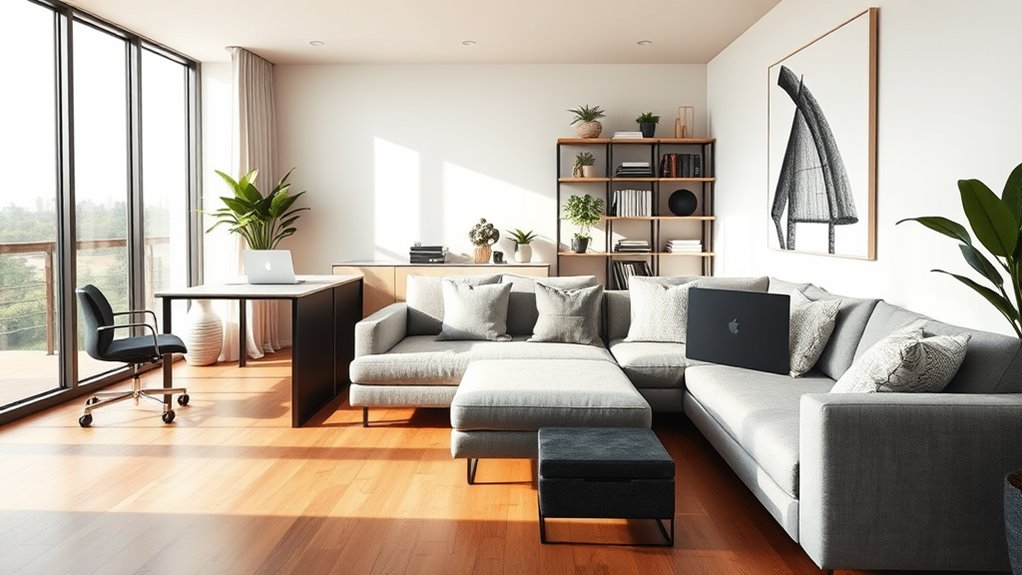
Multifunctional rooms are transforming the way we use our living spaces, offering flexibility and efficiency in homes and offices alike. These spaces are designed to serve more than one purpose, making them ideal for maximizing square footage and adapting to your changing needs. When you create a multifunctional room, you’re effectively optimizing space, which is especially important if your living area is limited. Instead of dedicating separate rooms for work and leisure, you can combine them into one cohesive space that works for you. This approach not only saves room but also streamlines your daily routines, reducing clutter and creating a more organized environment.
One of the key benefits of multifunctional rooms is decor versatility. You have the freedom to choose furniture and design elements that can serve multiple functions without sacrificing style. For example, a sofa bed provides comfortable seating during the day and transforms into a bed at night, blending practicality with aesthetic appeal. Modular furniture pieces allow you to reconfigure the space as needed, whether you’re hosting guests or setting up a workspace. By selecting adaptable decor, you can make your room feel fresh and personalized, no matter how many roles it has to play. This flexibility encourages creativity, letting you mix and match colors, textures, and accessories to suit your mood or the season.
In creating a multifunctional room, you should consider how to delineate different zones without cluttering the space. Using rugs, lighting, and furniture placement helps define areas for working, relaxing, or entertaining while maintaining an open, airy feel. Smart storage solutions are essential for keeping things tidy; think shelves, hidden compartments, and multi-purpose furniture with built-in storage. These elements help you keep clutter out of sight, making the space more inviting and functional. Additionally, incorporating technology—like fold-away desks or wall-mounted screens—can further enhance space efficiency without sacrificing comfort or style.
Furthermore, understanding the importance of space optimization can significantly enhance the usability of your multifunctional room, ensuring that every inch serves a purpose effectively. Ultimately, designing a multifunctional room is about balancing practicality with aesthetic appeal. You want a space that adapts to your lifestyle, whether you’re working remotely, exercising, or unwinding. By focusing on space optimization and decor versatility, you create a dynamic environment that evolves with you. With thoughtful planning and creative touches, your combined living and work area becomes more than just a room—it becomes a versatile hub tailored to your needs, making everyday life easier and more enjoyable.
Frequently Asked Questions
How Can I Improve Privacy in a Multifunctional Space?
To improve privacy in a multifunctional space, you should use privacy screens to create visual separation and reduce distractions. Incorporate flexible furniture, like fold-away desks or movable partitions, so you can easily adjust the layout when needed. These solutions help you carve out private areas for work or relaxation without sacrificing the room’s overall functionality. With these strategies, you’ll enjoy a more focused and private environment.
What Are the Best Colors for Combining Work and Living Areas?
You should choose colors based on color psychology to foster both productivity and relaxation. Soft blues and greens promote calm and focus, while warm neutrals like beige or taupe create design harmony and comfort. Incorporating accent colors like muted yellows or terracotta can add warmth without overwhelming the space. Balance these hues to define zones clearly, helping you switch between work and leisure smoothly in your combined living and work area.
How Do I Organize Storage Effectively in a Small Multifunctional Room?
Smart storage solutions simplify your small space. Start by selecting decorative storage options that blend seamlessly with your decor, making clutter less conspicuous. Incorporate modular furniture that’s versatile—think fold-away desks or stackable shelves—to maximize functionality. Use vertical space with wall-mounted shelves and hide everyday essentials in stylish bins or baskets. With clever coordination, your compact room stays clutter-free, creating a comfortable, coordinated environment for both work and relaxation.
What Lighting Options Suit Both Work and Relaxation Zones?
You should combine natural light with task lighting to suit both work and relaxation zones. Maximize natural light during the day with large windows or skylights, creating a bright, inviting space. Use adjustable task lights for focused work, like desk lamps or under-cabinet lighting, and softer ambient lighting for relaxation. This layered lighting approach guarantees your room stays functional and cozy, no matter the activity.
How Can I Soundproof a Multifunctional Room?
Think of your room as a quiet pond, undisturbed by outside noise. To soundproof it, use soundproofing techniques like sealing gaps and installing acoustic panels, which act like a calming barrier on the water’s surface. These panels absorb sound waves, reducing echoes and noise transfer. Combining these methods creates a peaceful haven, perfect for both working efficiently and relaxing without interruptions.
Conclusion
By designing multifunctional rooms, you turn your space into a powerhouse of productivity and comfort. Imagine transforming a single room into a seamless haven that adapts to every need—making your home feel more spacious than a mansion. With clever layout and smart furniture, you’ll create an environment so versatile, it’s like having multiple homes in one. Embrace these ideas, and watch your living and working space become the envy of everyone you know.
